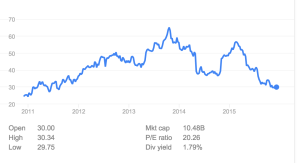Whole Foods Market: Adapting to a competitive natural foods grocery store environment

Whole Foods Market (WFM) is a premier natural foods grocery company, also known as “America’s Healthiest Grocery Store”. In addition, Whole Foods has been touted as one of the “100 Best Companies to Work For” by Fortune Magazine and consistently been a leader in corporate social responsibility. (Source: Wikipedia)
Despite Whole Foods Markets historical success and continual expansion, in recent years WFM has faced margin pressures and come up against a slew of competition both from traditional grocery and big-box retail stores like Walmart and Kroger as well as smaller organic food chains like Sprouts of Trader Joe’s. Competition is often providing similar natural and organic items at lower prices, especially larger retail stores that have better pricing leverage. In the past year, Whole Foods stock price has plummeted significantly. WFM is currently trading at ~$30/share, more than 50% lower than it’s high in 2013 of ~$65/share.
(Source: Yahoo Finance)
As the grocery environment changes, Whole Foods is at risk of not effectively realigning and adapting their operating model to support a changing grocer retail business model of more low-price for value items for customers. Wall Street has similar sentiments that Whole Foods has not properly positioned itself among new competitors such as Costco or Walmart that are now offering cheaper organic and natural food options in their stores. Nicknamed “Whole Paycheck” many on Wall Street have sourced on Whole Foods potential to realize operational efficiencies in order to provide lower price points compared to competitors eating away market share. (Source: NY Times: “Wall Street sources on Whole Foods Market,” Nov 2, 2015)
Whole Foods’s business model focuses on providing quality, natural foods for it’s customers including organic foods, albeit at a much higher mark-up compared to normal grocery stores. One of the main benefits of Whole Foods was the ability to provide to its customers shopper items you couldn’t get anywhere else. This was supported by the company’s operating model, a highly decentralized structure that enabled store and regional managers to utilize “foragers” and employees to source local and regional products in the area. However, the growth of small organic food businesses like Sprouts, have provided alternative shopping items for customers at lower price alternatives than Whole Foods. As Whole Foods Market expands its stores into environments that aren’t as amenable to the “whole paycheck” price tag for organic, healthy food, Whole Foods Market needs to reconsider how to align it’s core business and portfolio of providing natural / organic products to it’s customers. As Whole Foods Market’s facing margin pressures, it will need to think about was to improve its cost restructure but ultimately will need to find growth opportunities as well.
One avenue Whole Foods Market has leveraged to better align models is the launch of the “365″ store, essentially a lower cost alternative to its flagship Whole Foods Market store which more readily aligns to the more competitive low-price environment of natural, healthy grocer options and also supports Whole Foods Markets expansion into lower income markets where a lower price point store is likely to be more competitive than the original Whole Foods Market concept. While the current Whole Foods Market store does not give the company the competitive advantage against existing and new entrants, I support the Whole Foods Market vision of the “365 store” to provide a new concept of a new store with an operating model that supports a lower cost business model for its customers.




This is a very interesting time for Whole Foods and I’m eager to see how they adapt. I have a friend who works at the Whole Kids Foundation and she told me that they are centralizing some operations in order to realize efficiencies, although this might be misaligned with their business model of providing unique natural items and tailored service. Specifically, she said that each store used to have an in-house nutritionist, but now they’re adopting a regional model.
In spite of the identity crisis, I think Whole Foods still has the upper hand on quality. This asset may be hard to scale into markets that can’t support the “whole paycheck” price tag, though, as you mention.
Thanks for your post!
Interesting blog – and an interesting company. Seems like the operating model for WFM is getting strained by other , more efficient solutions… might explain the efficiency improvements…
I really liked WFM until I realized, like you mentioned on the post, that I can buy some of their products at other grocery stores now at lower prices. I even can buy my TruRoots quinoa on amazon now for 20% cheaper. And then 9 of their stores in the NY area started artificially inflating prices to charge even more towards the middle of this year.